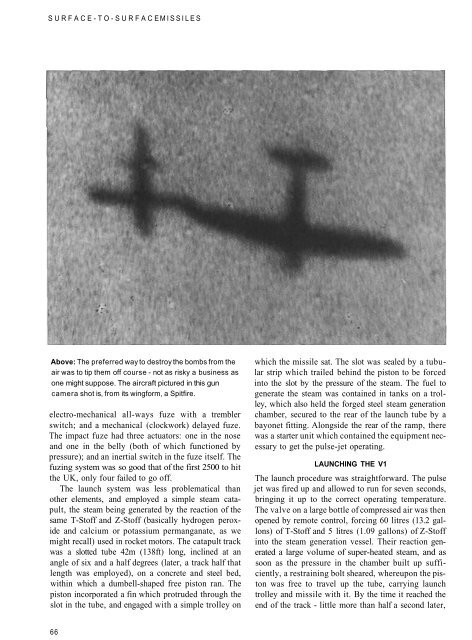Submarines and their Weapons - Aircraft of World War II
Submarines and their Weapons - Aircraft of World War II
Submarines and their Weapons - Aircraft of World War II
Create successful ePaper yourself
Turn your PDF publications into a flip-book with our unique Google optimized e-Paper software.
SURFACE-TO-SURFACE MISSILES<br />
Above: The preferred way to destroy the bombs from the<br />
air was to tip them <strong>of</strong>f course - not as risky a business as<br />
one might suppose. The aircraft pictured in this gun<br />
camera shot is, from its wingform, a Spitfire.<br />
electro-mechanical all-ways fuze with a trembler<br />
switch; <strong>and</strong> a mechanical (clockwork) delayed fuze.<br />
The impact fuze had three actuators: one in the nose<br />
<strong>and</strong> one in the belly (both <strong>of</strong> which functioned by<br />
pressure); <strong>and</strong> an inertial switch in the fuze itself. The<br />
fuzing system was so good that <strong>of</strong> the first 2500 to hit<br />
the UK, only four failed to go <strong>of</strong>f.<br />
The launch system was less problematical than<br />
other elements, <strong>and</strong> employed a simple steam catapult,<br />
the steam being generated by the reaction <strong>of</strong> the<br />
same T-St<strong>of</strong>f <strong>and</strong> Z-St<strong>of</strong>f (basically hydrogen peroxide<br />
<strong>and</strong> calcium or potassium permanganate, as we<br />
might recall) used in rocket motors. The catapult track<br />
was a slotted tube 42m (138ft) long, inclined at an<br />
angle <strong>of</strong> six <strong>and</strong> a half degrees (later, a track half that<br />
length was employed), on a concrete <strong>and</strong> steel bed,<br />
within which a dumbell-shaped free piston ran. The<br />
piston incorporated a fin which protruded through the<br />
slot in the tube, <strong>and</strong> engaged with a simple trolley on<br />
66<br />
which the missile sat. The slot was sealed by a tubular<br />
strip which trailed behind the piston to be forced<br />
into the slot by the pressure <strong>of</strong> the steam. The fuel to<br />
generate the steam was contained in tanks on a trolley,<br />
which also held the forged steel steam generation<br />
chamber, secured to the rear <strong>of</strong> the launch tube by a<br />
bayonet fitting. Alongside the rear <strong>of</strong> the ramp, there<br />
was a starter unit which contained the equipment necessary<br />
to get the pulse-jet operating.<br />
LAUNCHING THE V1<br />
The launch procedure was straightforward. The pulse<br />
jet was fired up <strong>and</strong> allowed to run for seven seconds,<br />
bringing it up to the correct operating temperature.<br />
The valve on a large bottle <strong>of</strong> compressed air was then<br />
opened by remote control, forcing 60 litres (13.2 gallons)<br />
<strong>of</strong> T-St<strong>of</strong>f <strong>and</strong> 5 litres (1.09 gallons) <strong>of</strong> Z-St<strong>of</strong>f<br />
into the steam generation vessel. Their reaction generated<br />
a large volume <strong>of</strong> super-heated steam, <strong>and</strong> as<br />
soon as the pressure in the chamber built up sufficiently,<br />
a restraining bolt sheared, whereupon the piston<br />
was free to travel up the tube, carrying launch<br />
trolley <strong>and</strong> missile with it. By the time it reached the<br />
end <strong>of</strong> the track - little more than half a second later,


